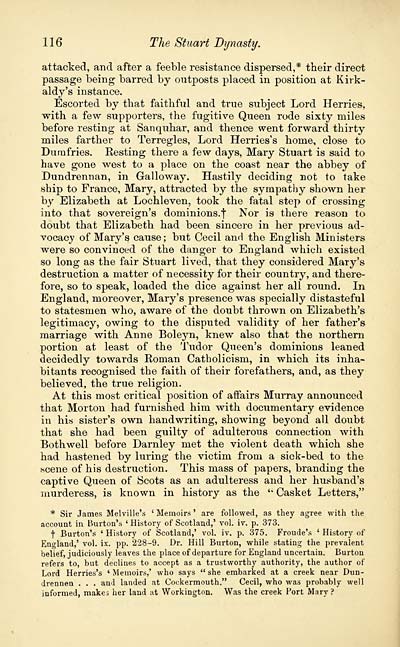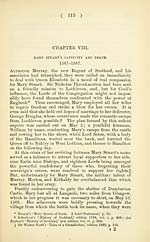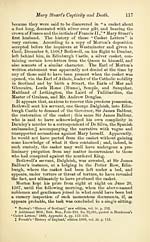Stuart dynasty
(136) Page 116
Download files
Complete book:
Individual page:
Thumbnail gallery: Grid view | List view

116 The Stuart Dynasty.
attacked, and after a feeble resistance dispersed,* their direct
passage being barred by outposts placed in position at Kirk-
aldy's instance.
Escorted by that faithful and true subject Lord Herries,
with a few supporters, the fugitive Queen rode sixty miles
before resting at Sanquhar, and thence went forward thirty
miles farther to Terregles, Lord Herries's home, close to
Dumfries. Resting there a few days, Mary Stuart is said to
have gone west to a place on the coast near the abbey of
Dundrennan, in Galloway. Hastily deciding not to take
ship to France, Mary, attracted by the sympathy shown her
by Elizabeth at Lochleven, took the fatal step of crossing
into that sovereign's dominions.")" Nor is there reason to
doubt that Elizabeth had been sincere in her previous ad-
vocacy of Mary's cause; but Cecil and the English Ministers
were so convinced of the danger to England which existed
so long as the fair Stuart lived, that they considered Mary's
destruction a matter of necessity for their country, and there-
fore, so to speak, loaded the dice against her all round. In
England, moreover, Mary's presence was specially distasteful
to statesmen who, aware of the doubt thrown on Elizabeth's
legitimacy, owing to the disputed validity of her father's
marriage with Anne Boleyn, knew also that the northern
portion at least of the Tudor Queen's dominions leaned
decidedly towards Roman Catholicism, in which its inha-
bitants recognised the faith of their forefathers, and, as they
believed, the true religion.
At this most critical position of affairs Murray announced
that Morton had furnished him with documentary evidence
in his sister's own handwriting, showing beyond all doubt
that she had been guilty of adulterous connection with
Bothwell before Darnley met the violent death which she
had hastened by luring the victim from a sick-bed to the
scene of his destruction. This mass of papers, branding the
captive Queen of Scots as an adulteress and her husband's
murderess, is known in history as the " Casket Letters,"
* Sir James Melville's ' Memoirs ' are followed, as they agree with the
account in Burton's ' History of Scotland,' vol. iv. p. 373.
f Burton's ' History of Scotland,' vol. iv. p. 375. Froude's ' History of
England,' vol. ix. pp. 228-9. Dr. Hill Burton, while stating the prevalent
belief, judiciously leaves the place of departure for England uncertain. Burton
refers to, but declines to accept as a trustworthy authority, the author of
Lord Herries's ' Memoirs,' who says " she embarked at a creek near Dun-
drennen . . . and landed at Cockermouth." Cecil, who was probably well
informed, make., her land at Workington. Was the creek Port Mary?
attacked, and after a feeble resistance dispersed,* their direct
passage being barred by outposts placed in position at Kirk-
aldy's instance.
Escorted by that faithful and true subject Lord Herries,
with a few supporters, the fugitive Queen rode sixty miles
before resting at Sanquhar, and thence went forward thirty
miles farther to Terregles, Lord Herries's home, close to
Dumfries. Resting there a few days, Mary Stuart is said to
have gone west to a place on the coast near the abbey of
Dundrennan, in Galloway. Hastily deciding not to take
ship to France, Mary, attracted by the sympathy shown her
by Elizabeth at Lochleven, took the fatal step of crossing
into that sovereign's dominions.")" Nor is there reason to
doubt that Elizabeth had been sincere in her previous ad-
vocacy of Mary's cause; but Cecil and the English Ministers
were so convinced of the danger to England which existed
so long as the fair Stuart lived, that they considered Mary's
destruction a matter of necessity for their country, and there-
fore, so to speak, loaded the dice against her all round. In
England, moreover, Mary's presence was specially distasteful
to statesmen who, aware of the doubt thrown on Elizabeth's
legitimacy, owing to the disputed validity of her father's
marriage with Anne Boleyn, knew also that the northern
portion at least of the Tudor Queen's dominions leaned
decidedly towards Roman Catholicism, in which its inha-
bitants recognised the faith of their forefathers, and, as they
believed, the true religion.
At this most critical position of affairs Murray announced
that Morton had furnished him with documentary evidence
in his sister's own handwriting, showing beyond all doubt
that she had been guilty of adulterous connection with
Bothwell before Darnley met the violent death which she
had hastened by luring the victim from a sick-bed to the
scene of his destruction. This mass of papers, branding the
captive Queen of Scots as an adulteress and her husband's
murderess, is known in history as the " Casket Letters,"
* Sir James Melville's ' Memoirs ' are followed, as they agree with the
account in Burton's ' History of Scotland,' vol. iv. p. 373.
f Burton's ' History of Scotland,' vol. iv. p. 375. Froude's ' History of
England,' vol. ix. pp. 228-9. Dr. Hill Burton, while stating the prevalent
belief, judiciously leaves the place of departure for England uncertain. Burton
refers to, but declines to accept as a trustworthy authority, the author of
Lord Herries's ' Memoirs,' who says " she embarked at a creek near Dun-
drennen . . . and landed at Cockermouth." Cecil, who was probably well
informed, make., her land at Workington. Was the creek Port Mary?
Set display mode to:
![]() Universal Viewer |
Universal Viewer | ![]() Mirador |
Large image | Transcription
Mirador |
Large image | Transcription
Images and transcriptions on this page, including medium image downloads, may be used under the Creative Commons Attribution 4.0 International Licence unless otherwise stated. ![]()
| Histories of Scottish families > Stuart dynasty > (136) Page 116 |
|---|
| Permanent URL | https://digital.nls.uk/94819398 |
|---|
| Description | A selection of almost 400 printed items relating to the history of Scottish families, mostly dating from the 19th and early 20th centuries. Includes memoirs, genealogies and clan histories, with a few produced by emigrant families. The earliest family history goes back to AD 916. |
|---|

